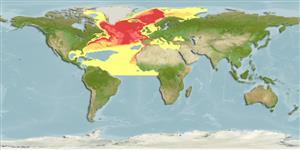Mammalia |
Cetartiodactyla |
Ziphiidae
Environment: milieu / climate zone / depth range / distribution range
Ecology
Pelagic; depth range 0 - 1453 m (Ref. 122879). Temperate; 90°N - 0°S, 180°W - 180°E
Atlantic Ocean, Arctic and the Mediterranean. Temperate to Subarctic.
Length at first maturity / Size / Weight / Age
Maturity: Lm ? range ? - ? cm Max length : 980 cm TL male/unsexed; (Ref. 1394); 870 cm TL (female)
Found in deep waters, mostly seaward of the continental slope. Feeds on squid, fish, sea cucumbers, starfish, and prawns on or near the bottom (Ref. 1394). Maximum depth recorded lasted for 70.5 minutes (Ref. 122879). Found in deep waters, mostly seaward of the continental slope. Feeds on squid, fish, sea cucumbers, starfish, and prawns on or near the bottom (Ref. 1394).
Life cycle and mating behavior
Maturity | Reproduction | Spawning | Eggs | Fecundity | Larvae
Jefferson, T.A., S. Leatherwood and M.A. Webber 1993 FAO species Identification Guide: Marine Mammals of the World. Rome, FAO. 320 p. + 587 figures. (Ref. 1394)
IUCN Red List Status
(Ref. 130435: Version 2025-1)
CITES status (Ref. 108899)
Threat to humans
Human uses
Fisheries: commercial
FAO - Fisheries: landings, species profile | FishSource | Sea Around Us
Tools
More information
Population dynamicsGrowthMax. ages / sizesLength-weight rel.Length-length rel.Length-frequenciesMass conversionAbundance Life cycleReproductionMaturityFecunditySpawningEggsEgg developmentLarvae PhysiologyOxygen consumption
Human RelatedStamps, coins, misc.
Internet sources
Estimates based on models
Preferred temperature
(Ref.
115969): -0.9 - 4.4, mean 3.2 (based on 712 cells).
Fishing Vulnerability
Very high vulnerability (90 of 100).
Price category
Unknown.
